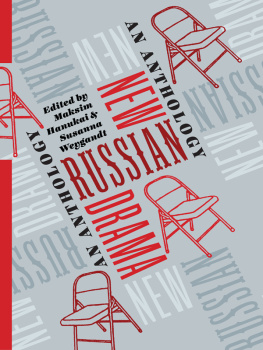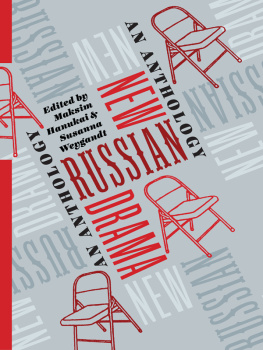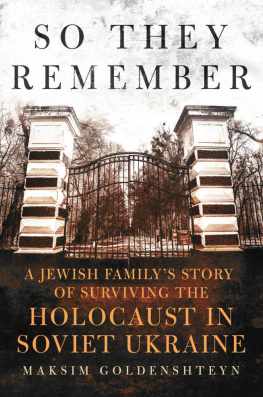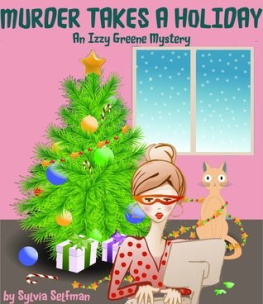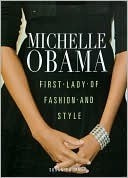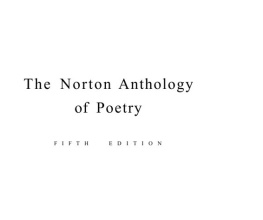Table of Contents
NEW RUSSIAN DRAMA
RUSSIAN LIBRARY
The Russian Library at Columbia University Press publishes an expansive selection of Russian literature in English translation, concentrating on works previously unavailable in English and those ripe for new translations. Works of premodern, modern, and contemporary literature are featured, including recent writing. The series seeks to demonstrate the breadth, surprising variety, and global importance of the Russian literary tradition and includes not only novels but also short stories, plays, poetry, memoirs, creative nonfiction, and works of mixed or fluid genre.
Editorial Board:
Vsevolod Bagno
Dmitry Bak
Rosamund Bartlett
Caryl Emerson
Peter B. Kaufman
Mark Lipovetsky
Oliver Ready
Stephanie Sandler
For a list of books in the series, see
Published with the support of Read Russia, Inc., and the Institute of Literary Translation, Russia
Columbia University Press
Publishers Since 1893
New York Chichester, West Sussex
cup.columbia.edu
Translation copyright 2019 Columbia University Press
All rights reserved
E-ISBN 978-0-231-54584-6
Library of Congress Cataloging-in-Publication Data
Names: Hanukai, Maksim, editor. | Weygandt, Susanna, editor.
Title: New Russian drama: an anthology / edited by Maksim Hanukai and Susanna Weygandt.
Description: New York: Columbia University Press, 2019. | Series: Russian library
Identifiers: LCCN 2018052747 (print) | LCCN 2018059157 (e-book) | ISBN 9780231545846 (electronic) | ISBN 9780231185103 (cloth: alk. paper) | ISBN 9780231185110 (pbk.)
Subjects: LCSH: Russian drama20th centuryTranslations into English.
Classification: LCC PG3245 (e-book) | LCC PG3245 .N49 2019 (print) | DDC 891.7208dc23
LC record available at https://lccn.loc.gov/2018052747
A Columbia University Press E-book.
CUP would be pleased to hear about your reading experience with this e-book at .
Cover design: Roberto de Vicq de Cumptich
Book design: Lisa Hamm
CONTENTS
by Richard Schechner
by Maksim Hanukai and Susanna Weygandt
by Vassily Sigarev
by the Presnyakov Brothers
by Elena Gremina and Mikhail Ugarov
by Elena Gremina
by Mikhail Durnenkov
by Pavel Pryazhko
by Pavel Pryazhko
by Ivan Vyrypaev
by Yaroslava Pulinovich
by Andrey Rodionov and Ekaterina Troepolskaya
RICHARD SCHECHNER
W hen I was growing up in the theater more than a half-century ago, it was all Russia. Yes, we knew about Brecht, barely, and the dramaplayswas American and international; but the theater, that was Russian. Not purely Russian, but doubly filtered. Stanislavski was with us in translation, first My Life in Art and then An Actor Prepares. But more important, Stanislavskis deputies controlled the serious American theater (not the commercial side of Broadway). The Group Theatre people were vitally workingHarold Clurman, Elia Kazan, Stella Adler, Sandford Meisner. And before that, in 1923, defectors from the Moscow Art Theater/USSR, Maria Ouspenskaya and Richard Boleslavsky, started the American Laboratory Theatre, bringing to the New World what they knew of Stanislavski, firsthand. The impact of Stanislavski thenand even nowcannot be overestimated, in the theater and then in the movies and on to television. A kind of realism, softened to be sure (as you will see when you read the book in your hands), but pedestrian enough in the way that postmodern dance featured the way people really moved. The American Lab and the Group Theatre featured not so much behavior, the outside, but the insidethe way people really felt. At least that was the guiding principle.
And then came Lee Strasberg, another Group Theatre alumnus, who thought he knew Stanislavski better than the master knew himself. And maybe Strasberg was right. He took Stanislavskis relatively early way of working by means of affective/emotional memory and developed it into The Methodmining the real emotions of actors and inserting these emotions into the onstage life of the characters. It was not so much building a character that is other as recollecting and abreacting ones own emotions and then applying these to the role. In todays lingo, it was a cut-and-paste job. To put it bluntly: the tears, delights, rages, sexual arousals, jealousiesthe whole gamut of human feelingshad once really happened to the actors as people. And now they learned how to make them really happen again, and again. Strasberg taught actors how to access these very powerful personal emotions, repeat them, and skillfully embed them in the behavior of the characters. This kind of really real was new for the American stage. It worked even better on film, where editing, camera angle, close-ups, and miking brought movie audiences right into the emotional turmoil and triumph of the characters.
WeI and a bunch of others kind of like me (The Living Theatre, The Open Theatre, Robert Wilson, Richard Foreman, Mabou Mines, postmodern choreographer-dancers, Happeners) rebelled against all this. Who did we look to for guidance? Not Bertolt Brecht, who was in the United States from 1941 to 1947too early to directly affect us. Somewhat to Brechts colleague, Erwin Piscator, who emigrated to New York in 1937 and ran his Dramatic Workshop from 1940 to 1951. Judith Malina, cofounder of The Living Theatre with Julian Beck, was one of Piscators students.
No, we took after Vsevolod Meyerhold, Yevgeny Vakhtangov, and Michael Chekhovstudents, then colleagues, then rebels in relation to Stanislavski. Expressionism, biomechanics, and the psychological gesture replaced Stanislavskis soft-tinted naturalism. For Meyerhold, the life of the collective mattered most: the emerging epoch of the machine, the factory worker, the utopian side of the Russian Revolution. All that was cut down by Stalin and his murderous regime and overtaken by Socialist Realism, a grotesque parody of both socialism and realism. Meyerhold was arrested and tortured by Stalins police in 1939, then murdered in 1940. In 1922, the year of his death, Vakhtangov directed Anskys The Dybbuk in Hebrew at the Moscow Art Theater. Four years later, Habima got away to Palestine where it became, in time, Israels national theater. Michael Chekhov came to America in 1938 and revitalized acting, offering a powerful alternative to The Method. What the avant-garde of the American 60s took from these Russian migrs, followers-then-not-followers of Stanislavski, was an intense dedication to both process and experimentationalways searching for the authentic, the real, even if these were not naturalistic in terms of current style. The range of outflow from Russia/USSR up to the 1930s was extraordinary.






